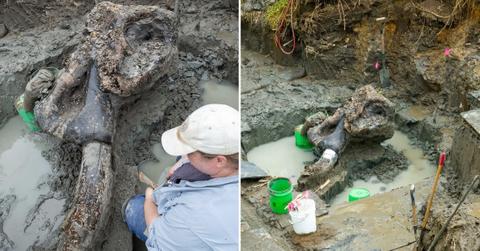Digging Deep: Archaeologists in Iowa Uncover 14,000-Year-Old Mastodon Skull

The OSA team worked in August 2024 to excavate the skull and several additional mastodon bones.
University of Iowa archaeologists have made a historic discovery, unearthing the first well-preserved mastodon skull to be scientifically excavated in Iowa.
This significant find dates back to a time when the first humans lived and hunted in the area.
Mastodons were large mammals similar to elephants and mammoths, roaming North America from about 3.5 million years ago until 10,500 years ago.
In the fall of 2022, John Doershuk, director and state archaeologist at the University of Iowa’s Office of the State Archaeologist (OSA), and his team were alerted by a Wayne County resident who had heard of a large bone found in a creek bed on private property in the county's southwest. This bone, a mastodon femur, piqued the team's interest.
Upon investigating the site the following fall, the team discovered a broken tusk emerging from the creek bed. Clues suggested that the tusk was still attached to the skull, prompting a more detailed scientific investigation.
Securing funding from the Wayne County Foundation and donations to the Prairie Trails Museum of Corydon, Iowa, the OSA team returned in August 2024 to carefully excavate the skull along with several other mastodon bones, all likely from the same animal.
Radiocarbon dating revealed the skull to be approximately 13,600 years old — a period that coincides with human occupation in the region.
“This overlap raises the possibility of discovering evidence of human interaction with the mastodon,” Doershuk explains. “We’re hoping to find artifacts like projectile points or knives used to hunt or butcher the animal, and possibly even cut marks on the bones themselves.”
- Oregon Man Arrested for Making 'Concerning Social Media Posts' About UConn Basketball Star Paige Bueckers: Police
- Idaho College Murders: New Mugshot of Bryan Kohberger Released Following Major Court Decision
- Good Samaritan in South Carolina Rescues Clemson Student from Attack by Convicted Sex Offender: Sheriff
Never miss a story — sign up for the Front Page Detectives newsletter. Be on the scene the moment news breaks.
The archaeologists work to excavate the bones in southern Iowa.
During the 12-day excavation, the team also unearthed several human-made artifacts, including stone tools. Although these tools were dated a few thousand years after the mastodon, their presence is encouraging, suggesting a previously unrecorded human presence in the creek area. Further analysis of these artifacts and the bones’ positioning could shed light on human interactions with the mastodon and how the animal ended up in the creek bed.
The OSA and the UI Paleontology Repository, located in the Department of Earth and Environmental Sciences, will analyze and conserve the mastodon skull and other bones recovered from the site. Once this work is completed, the bones will be displayed in a new exhibit at the Prairie Trails Museum.
Become a Front Page Detective
Sign up to receive breaking
Front Page Detectives
news and exclusive investigations.
